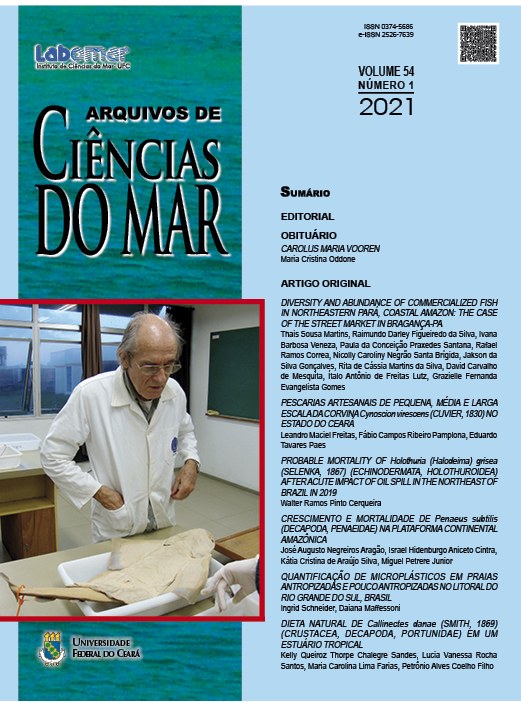Artisanal fisheries of the small, medium and large scale of Cynoscion virescens (Cuvier, 1830) in the state of Pará
DOI:
https://doi.org/10.32360/acmar.v54i1.42397Abstract
The corvina or pescada cambuçu Cynoscion virescens is one of the main species of scianidae caught in Pará artisanal fishing. During the Estatpesca program, from 1997 to 2007, occurred in 0.99% of monitored landings, were 0.15% of landed total production, and their data showed a tendency to increase production between 2005 and 2007. In the frequency and average landed, São João de Pirabas was featured, but in the landed total quantity, Belém stood out, boosted by the increased frequency of landings of small and medium size vessels in the last three years of monitoring. The curral and the gillnets, serreira and gozeira, were the most frequent rigs, but the nets presented the largest volume landed. Among the vessels, canoas most frequently and with larger landed biomass. Regarding the CPUEs, the nets were correlated with the number of fishermen. The curral were analyzed solely with their quantities in the monitoring and the canoes with the days at sea. Only the gillnets showed significant differences. Cluster analysis showed five landing groups
between municipalities: groups with null, small and regular landings, zero landing groups between 1998 and 1999, and those with a growth trend from 2005 to 2007.
Keywords: catch, rigs, vessels, coastal zone, estuary
Downloads
Downloads
Published
How to Cite
Issue
Section
License
1. Proposta de Política para Periódicos de Acesso Livre
Autores que publicam nesta revista concordam com os seguintes termos:
- Autores mantém os direitos autorais e concedem à revista o direito de primeira publicação, com o trabalho simultaneamente licenciado sob a Licença Creative Commons Attribution que permite o compartilhamento do trabalho com reconhecimento da autoria e publicação inicial nesta revista.
- Autores têm autorização para assumir contratos adicionais separadamente, para distribuição não-exclusiva da versão do trabalho publicada nesta revista (ex.: publicar em repositório institucional ou como capítulo de livro), com reconhecimento de autoria e publicação inicial nesta revista.
- Autores têm permissão e são estimulados a publicar e distribuir seu trabalho online (ex.: em repositórios institucionais ou na sua página pessoal) a qualquer ponto antes ou durante o processo editorial, já que isso pode gerar alterações produtivas, bem como aumentar o impacto e a citação do trabalho publicado (Veja O Efeito do Acesso Livre).

